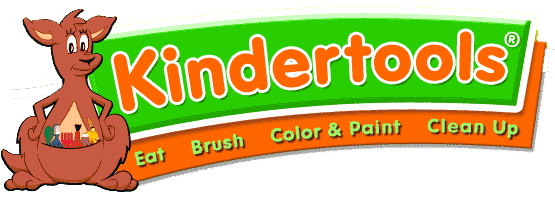Frequently Asked Questions
“Are Kindertools dishwasher safe?”
Yes (all except for the crayons!). In fact, we recommend before first using Kindertools that you wash them in the dishwasher (or in warm soapy water). Also remember that when Kindertools are not in use, the patented handle allows them to stand in an upright position so they can remain cleaner and more sanitary, as well as easy to grasp when picked up by a child or adult.
“Do Kindertools break easily?”
No. Kindertools are made of a durable plastic designed to be “child proof.” In the unlikely event that any of your Kindertools do break, please send us the broken tool and we’ll replace it immediately at no charge.
“What is the ideal age for a child to use Kindertools?”
In general, Kindertools are designed for children between 6 months and 6 years of age. Within that age range, what is ideal will vary depending on the specific tool in question as well as from one child to another.
For example, infants as young as 6 months of age can use the Infant Teething Brush when their first teeth appear. For older children (ages 2-6) this same tool can be used as a scrubber for clean up instead. The Toddler Brush is appropriate for ages 2-6 or from the time molars appear until a child is ready for a standard toothbrush. The Kindertools crayon and paintbrush holders can allow a child as young as 6 months to 1 year old to color, draw or paint and can continue to be used even past age 6 if necessary.
Obviously, children develop and mature at a different pace in different areas. Therefore, the best way to determine the ideal age for your child to use each tool is through trial and error. We do suggest, however, getting a child started with each tool as soon as it is possible not only to take advantage of the many benefits that Kindertools provide but also because, regardless of a child’s state of development and maturity, Kindertools are designed to accelerate each child’s skills and abilities so he/she can move on to more complex tasks sooner.
“How do I get the free coloring book?”
You can print the coloring book right from this website. Just go to the “Color KinderRoo” section of this website where the loveable Kindertools mascot “KinderRoo” can show you how.
“Are Kindertools also recommended for people with disabilities?”
Yes. The benefits of Kindertools are not limited to just children. Anyone who experiences difficulty or frustration with conventional spoons, forks, toothbrushes and/or writing instruments may also benefit from the many advantages Kindertools provide. This includes anyone with limited motor skills or range of motion such as elderly, disabled, and handicapped people as well as people with arthritis or those in rehabilitative or physical therapy programs. Unfortunately, just as with children, there has been little in the way of innovation or products to address the unique needs of these individuals despite the fact that many of the same areas that apply to children also apply to them:
- Frustration with trying to grip conventional utensils
- Discouragement and accidents with dropping utensils and food
- Need for tools with no hard or sharp edges which protect against over-insertion, injury or choking
- Need for tools designed to take advantage of the tendency to curl fingers and hold on tightly
- Need for tools which allow many easy ways to grip using either hand – however is most secure, comfortable and effective
- Need for tools which help brace the wrist and provide much better stability, control and maneuverability with less effort
- Need for tools which assist the smaller muscle groups leading to smoother more natural movements and helping maintain (or improve) motor skills and coordination
- Need for tools which help create independence, confidence and sense of success.
Obviously, children are not the only ones who need safe, practical and effective solutions to meet their unique needs. Kindertools can help daily tasks and activities become an easier, more comfortable and positive experience for many other people with unique needs as well.
